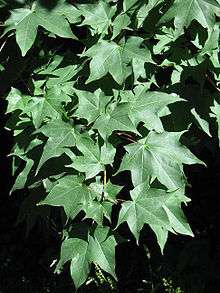Acer cappadocicum
| Acer cappadocicum | |
|---|---|
 | |
| Cappadocian maple leaves | |
| Scientific classification | |
| Kingdom: | Plantae |
| (unranked): | Angiosperms |
| (unranked): | Eudicots |
| (unranked): | Rosids |
| Order: | Sapindales |
| Family: | Sapindaceae[1] |
| Genus: | Acer |
| Species: | A. cappadocicum |
| Binomial name | |
| Acer cappadocicum Gled. 1785 | |
Acer cappadocicum (Cappadocian maple) is a maple native to Asia, from central Turkey (ancient Cappadocia) east along the Caucasus, the Himalaya, to southwestern China.[2][3][4][5][6]
It is a medium-sized deciduous tree growing to 20-30 m tall with a broad, rounded crown. The leaves are opposite, palmately lobed with 5-7 lobes, 6-15 cm across. The leaf stems bleed a milky latex when broken. The flowers are in corymbs of 15-30 together, yellow-green with five petals 3-4 mm long; flowering occurs in early spring. The fruit is a double samara with two winged seeds, the seeds are disc-shaped, strongly flattened, 6-11 mm across and 2-3 mm thick. The wings are 2.5-3 cm long, widely spread, approaching a 180° angle. The bark is greenish-grey, smooth in young trees, becoming shallowly grooved when mature.[2][3][5][6]
There are three varieties, sometimes treated as subspecies:[4][5]
- Acer cappadocicum var. cappadocicum. Turkey, Caucasus, northern Iran.
- Acer cappadocicum var. indicum (Pax) Rehd. (syn. var. cultratum (Wall.) Bean). Himalaya.
- Acer cappadocicum var. sinicum Rehd. Southwestern China.
The closely related Acer lobelii from southern Italy is also treated as a subspecies of A. cappadocicum by some authors.[5] The eastern Asian species Acer amplum, Acer pictum, and Acer truncatum are also very closely related, and often confused with A. cappadocicum in cultivation.[4]
Cultivation and uses

Cappadocian maple is grown as an ornamental tree in Europe. Many of the trees in cultivation show a strong tendency to produce numerous root sprouts, a character rare in maples.[2][3] The hybrid maple Acer × zoeschense shares this character and probably has Acer cappadocicum as one of its parents.[3]
The following cultivars have gained the Royal Horticultural Society's Award of Garden Merit:-
References
| Wikimedia Commons has media related to Acer cappadocicum. |
- ↑ Stevens, P. F. (2001 onwards). Angiosperm Phylogeny Website. Version 9, June 2008 [and more or less continuously updated since]. http://www.mobot.org/MOBOT/research/APweb/.
- 1 2 3 Mitchell, A. F. (1974). A Field Guide to the Trees of Britain and Northern Europe. Collins ISBN 0-00-212035-6
- 1 2 3 4 Mitchell, A. F. (1982). The Trees of Britain and Northern Europe. Collins ISBN 0-00-219037-0
- 1 2 3 Bean, W. J. (1976). Trees and Shrubs Hardy in the British Isles 8th ed., vol. 1. John Murray ISBN 0-7195-1790-7.
- 1 2 3 4 Huxley, A., ed. (1992). New RHS Dictionary of Gardening. Macmillan ISBN 0-333-47494-5.
- 1 2 Rushforth, K. (1999). Trees of Britain and Europe. Collins ISBN 0-00-220013-9.
- ↑ RHS Plant Selector Acer cappadocicum 'Aureum' AGM / RHS Gardening
- ↑ RHS Plant Selector Acer cappadocicum 'Rubrum' AGM / RHS Gardening